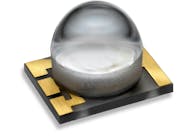When a Fortune 500 company in Colorado Springs decided to invest in a lighting retrofit at its corporate campus, management understood the project would not only save them substantially in energy costs but would also score them valuable good-will amongst their customer base. The only problem was going to be the logistical nightmare the three-week installation schedule caused and the waste it produced.
The company’s facilities at the corporate campus were constructed over the course of a couple of decades, utilizing the most energy-efficient materials and methods of the day and remained well-maintained over the years. The project would ultimately involve removing 5,500 fluorescent light fixtures, with an average of three lamps per unit. Primarily made up of linear fluorescent lamps, the average consumption was 32 w per lamp. Lighting the campus was using a little more than 3 Million kilowatt/hours of electricity a year.
By making the switch to an LED-based lighting system for the entire campus, plus adding some key energy-saving features, such as light harvesting and occupancy sensing controls, the company was going to bring consumption down to about 640,000 kilowatt/hours per year. The savings in electrical billing alone would pay for the project in less than three years. That doesn’t even factor in the longer life of the LED lamps over their fluorescent predecessors. The savings in lamp replacement and the labor associated with that had not even been factored into the project’s intended outcome.
ASG Energy, the contractor retained for the retrofit, understood that the project would require the use of storage space during the installation. By paying close attention to the footprint of the project’s prep needs, as well as the disposal needs, they were able to provide a reasonably accurate forecast of their space impact during the three-week project. Working almost exclusively during off-business hours, they managed the use of parking spaces as prep space and demolition space.
Demolition of the fixtures being replaced involved three important phases. First, the removal of the fluorescent lamps. ASG Energy understands well the EPA regulations on disposal of fluorescent bulbs. Because of the presence of mercury in fluorescent lamps, they need to be stored in a fashion that protects against accidental release of the mercury. That could have meant boxing and carefully storing more than 16,000 bulbs. Obviously, storing such a large number of bulbs until they’re picked up for disposal is a very inefficient use of space and manpower. ASG Energy chose to use a BulbEater® by TerraCycle drum-top bulb crushing unit to facilitate the storage of the waste bulbs. By compacting the bulbs in a drum-top crusher, they captured the dangerous mercury, while consolidating the space impact of the waste. The BulbEater® unit compacts more than 1,300 bulbs into a single, steel drum.
The next step in the demolition was to remove the ballast units from the fixtures. Ballasts made before 1980 contain highly toxic PCB and must never be disposed of in general waste. The Colorado Springs campus was built after 1980, and so the fixtures were non-PCB containing units, but even so, they do contain DEHP. DEHP has low toxicity in small amounts, say a couple of ballasts from a home, but when disposing of 5,500 it is environmentally responsible to set up a recycling program with a hazardous waste handler. ASG Energy contracted with the same handler for the ballasts and lamp waste, and were able to dispose of both economically and safely.
Finally, the fixtures themselves are excellent sources of recyclable metals. ASG Energy had a scrap metal company pick up the fixtures and turn them into valuable aluminum, steel and copper.
By utilizing environmentally sound practices, ASG Energy was able to perform a multi-million-dollar lighting retrofit while causing minimal work disruption to the employees of a Fortune 500 office. They provided their client with a new, high-efficiency lighting system that improved the work environment while saving a considerable amount of money. All while disposing of the old equipment in an environmentally conscious way.





